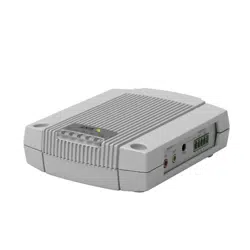Loading ...
Loading ...
Loading ...

27
AXIS P8221 - System Options
Notes:
• For NAT traversal to work, this must be supported by the broadband router. The router must also support UPnP
TM
.
• The broadband router has many different names: “NAT router”, “Network router“, Internet Gateway”, “Broadband
sharing device” or “Home firewall” but the essential purpose of the device is the same.
Enable/Disable – When enabled, the device attempts to configure port mapping in a NAT router on your network, using
UPnP™. Note that UPnP™ must be enabled in the device (see System Options > Network > UPnP).
Use manually selected NAT router – Select this option to manually select a NAT router and enter the IP address for the router
in the field provided.
If a router is not manually specified, the device automatically searches for NAT routers on your network. If more than one
router is found, the default router is selected.
Alternative HTTP port – Select this option to manually define an external HTTP port. Enter the port number in the field
provided. If no port is entered here a port number is automatically selected when NAT traversal is enabled.
Notes:
• An alternative HTTP port can be used/be active even if NAT traversal is disabled. This is useful if your NAT router does
not support UPnP and you need to manually configure port forwarding in the NAT router.
• If you attempt to manually enter a port that is already in use, another available port is automatically selected.
• When the port is selected automatically it is displayed in this field. To change this enter a new port number and click
Save.
FTP
The FTP server running in AXIS P8221 enables the upload of new firmware and user applications. Check the box to enable the
service.
RTSP
The RTSP protocol allows a connecting client to start an audio stream. Check the box to enable the server and enter the RTSP
port number to use. The default setting is 554. Note that audio streams will not be available if this service is not enabled.
SOCKS
SOCKS is a networking proxy protocol. The Axis product can be configured to use a SOCKS server to reach networks on the
other side of a firewall/proxy server. This functionality is useful if the product is located on a local network behind a firewall,
and notifications, alarms, and such need to be sent to a destination outside the local network (such as the Internet). See the
online help for more information.
QoS (Quality of Service)
Quality of Service (QoS) guarantees a certain level of a specified resource to selected traffic on a network. Quality can be
defined as a maintained level of bandwidth, low latency, and no packet losses. The main benefits of a QoS-aware network can
be summarized as:
• The ability to prioritize traffic and thus allow critical flows to be served before flows with lesser priority.
• Greater reliability in the network, thanks to the control of the amount of bandwidth an application may use, and thus
control over bandwidth races between applications.
The QoS in Axis products marks the data packets for various types of network traffic originating from the product. This makes
it possible for network routers and switches to reserve a fixed amount of bandwidth for these types of traffic. The device
marks the following types of traffic:
•live audio
•event/alarm
• management network traffic
Loading ...
Loading ...
Loading ...
